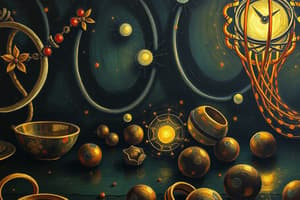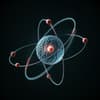Podcast
Questions and Answers
What was John Dalton’s major contribution to the classification of elements?
What was John Dalton’s major contribution to the classification of elements?
- He proposed the Law of Octaves.
- He classified elements into groups based on their properties.
- He suggested that all elements were multiples of Oxygen.
- He defined a way to determine atomic weights and rearranged a list in increasing order of mass. (correct)
What observation did William Prout make about atomic weights?
What observation did William Prout make about atomic weights?
- They were all equal to the weight of Oxygen.
- They followed the Law of Octaves.
- They could not be simplified.
- They seemed to be multiples of Hydrogen. (correct)
What method did Johann Wolfgang Döbereiner use to classify elements?
What method did Johann Wolfgang Döbereiner use to classify elements?
- He arranged them based on their density.
- He classified them based on their atomic numbers.
- He grouped them into pairs based on specific properties.
- He organized them into triads with a middle element displaying intermediate properties. (correct)
How did John Newlands contribute to the understanding of element classification?
How did John Newlands contribute to the understanding of element classification?
What was a notable feature of Dmitri Mendeleev's periodic table?
What was a notable feature of Dmitri Mendeleev's periodic table?
Why was Mendeleev able to address discrepancies in the periodic table?
Why was Mendeleev able to address discrepancies in the periodic table?
What was the primary focus of John Dalton's atomic theory?
What was the primary focus of John Dalton's atomic theory?
How did Lavoisier influence John Dalton's work?
How did Lavoisier influence John Dalton's work?
Which category of elements is primarily located on the right side of the periodic table?
Which category of elements is primarily located on the right side of the periodic table?
What is a characteristic of nonmetals?
What is a characteristic of nonmetals?
Which of the following elements is considered a metalloid?
Which of the following elements is considered a metalloid?
What is a distinguishing feature of metalloids?
What is a distinguishing feature of metalloids?
Which elements are considered part of the Lanthanide and Actinide series?
Which elements are considered part of the Lanthanide and Actinide series?
Which of the following statements about metals is true?
Which of the following statements about metals is true?
How do nonmetals generally behave in terms of electron configuration?
How do nonmetals generally behave in terms of electron configuration?
What characteristic is typical of metalloids?
What characteristic is typical of metalloids?
What does the effective nuclear charge represent?
What does the effective nuclear charge represent?
How does atomic radius change as you move down a group in the periodic table?
How does atomic radius change as you move down a group in the periodic table?
What is the typical range of atomic radii for most atoms?
What is the typical range of atomic radii for most atoms?
Which factor contributes to an increase in effective nuclear charge?
Which factor contributes to an increase in effective nuclear charge?
What determines the ionic radius of an element?
What determines the ionic radius of an element?
Why is it important to know the atomic radius in applications?
Why is it important to know the atomic radius in applications?
How do the forces of attraction and repulsion affect effective nuclear charge?
How do the forces of attraction and repulsion affect effective nuclear charge?
What does an increase in valence electrons do to effective nuclear charge?
What does an increase in valence electrons do to effective nuclear charge?
What occurs when electrons are removed from a parent atom to form a positive ion?
What occurs when electrons are removed from a parent atom to form a positive ion?
How does adding electrons to a parent atom affect its ionic radius?
How does adding electrons to a parent atom affect its ionic radius?
How is atomic radius defined in isoelectronic species?
How is atomic radius defined in isoelectronic species?
What defines ionization energy?
What defines ionization energy?
What effect does the addition of an electron have on the energy associated with electron affinity?
What effect does the addition of an electron have on the energy associated with electron affinity?
In what way does electronegativity influence atomic interactions?
In what way does electronegativity influence atomic interactions?
Which statement accurately describes the relationship between atomic radius and ionization energy?
Which statement accurately describes the relationship between atomic radius and ionization energy?
What can be inferred about the trend in ionic radius when comparing negative ions to positive ions?
What can be inferred about the trend in ionic radius when comparing negative ions to positive ions?
What describes metallic character in terms of electron behavior?
What describes metallic character in terms of electron behavior?
Which of the following statements about Group 1 metals is true?
Which of the following statements about Group 1 metals is true?
What trend is observed regarding the reactivity of Group 1 elements with water?
What trend is observed regarding the reactivity of Group 1 elements with water?
What defines non-metallic character?
What defines non-metallic character?
Which of the following statements about halogens is true?
Which of the following statements about halogens is true?
Why are pure alkali metals stored submerged in oils?
Why are pure alkali metals stored submerged in oils?
Which of the following is NOT a property of Group 1 metals?
Which of the following is NOT a property of Group 1 metals?
What is true about the reactivity of halogens?
What is true about the reactivity of halogens?
Flashcards are hidden until you start studying
Study Notes
Development of Atomic Theory
- John Dalton (1810) built on Lavoisier's work, determining atomic weights and rearranging elements by mass.
- Dalton excluded light and energy as elements.
- William Prout (1815) recognized atomic weights were multiples of Hydrogen, simplifying its weight to 1 unit.
Classification of Elements
- Johann Wolfgang Döbereiner (1817) classified elements into triads based on similar properties: the middle element had intermediate characteristics.
- John Newlands (1864) proposed the Law of Octaves, grouping elements into eight sets, indicating periodicity in properties.
Mendeleev's Periodic Table
- Dmitri Mendeleev (1869) created a table ordering elements by atomic mass and properties; discrepancies recognized due to undiscovered elements.
- Mendeleev's classification involved groups (columns) and periods (rows).
Element Categories
- Elements are divided into metals, nonmetals, and metalloids.
- Nonmetals are found on the right, characterized by brittleness, dull appearance, low melting points, and tendency to gain electrons.
- Metalloids lie between metals and nonmetals, showing intermediate properties, e.g., Silicon (Si) and Tellurium (Te).
Lanthanide and Actinide Series
- Lanthanide and actinide series are placed at the bottom of the periodic table, linked to their f orbital electron configurations.
Blocks in the Periodic Table
- Elements are categorized into blocks (s, p, d, f) based on outermost electron orbital shapes.
Periodic Trends: Effective Nuclear Charge
- Effective Nuclear Charge (ENC) is the net positive charge felt by valence electrons, influenced by proton and core electron interactions.
- ENC increases with the number of protons and valence electrons.
Periodic Trends: Atomic Radius
- Atomic radius is semi-defined as the Van der Waals distance between adjacent nuclei, typically ranging from 30 to 300 picometers.
- Atomic radius increases down a group and decreases across a period.
Periodic Trends: Ionic Radius
- Ionic radius varies with ionization: removing electrons (for positive ions) results in a smaller radius, while adding electrons (for negative ions) increases radius.
Isoelectronic Species
- For isoelectronic species, the radius decreases with increased effective nuclear charge.
Periodic Trends: Ionization Energy
- Ionization energy is the energy required to remove an electron from an atom's outer layer.
- Lower ionization energies lead to a higher tendency to lose electrons.
Periodic Trends: Electron Affinity
- Electron affinity measures the energy released when an electron is added to an atom, revealing tendencies for an atom to form anions.
Periodic Trends: Electronegativity and Character
- Electronegativity is the ability of an atom to attract electron pairs in covalent bonds.
- Metallic character corresponds to the tendency to lose electrons; non-metallic character relates to the tendency to gain electrons.
Group Properties
- Group 1 alkali metals have high reactivity, characterized by a single valence electron and soft metal structure.
- Alkali metals form compounds with water, reacting violently and are stored submerged in oil due to their reactivity.
Group 17: Halogens
- Halogens, meaning "salt makers," are highly electronegative and reactive, forming salts with metals.
- They exist in all three states: gases (F, Cl), liquids (Br), and solids (I, At, Ts) at room temperature.
Studying That Suits You
Use AI to generate personalized quizzes and flashcards to suit your learning preferences.




